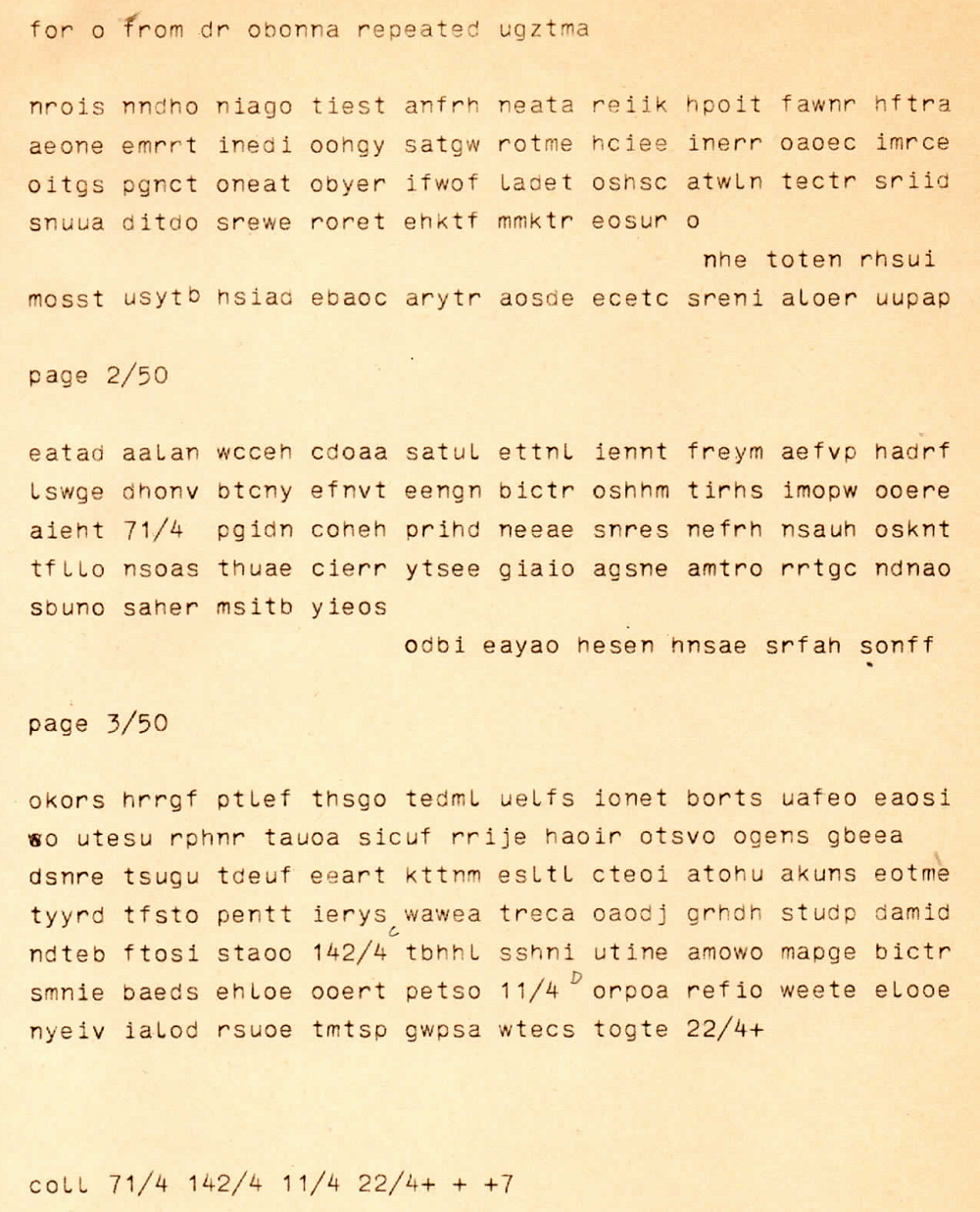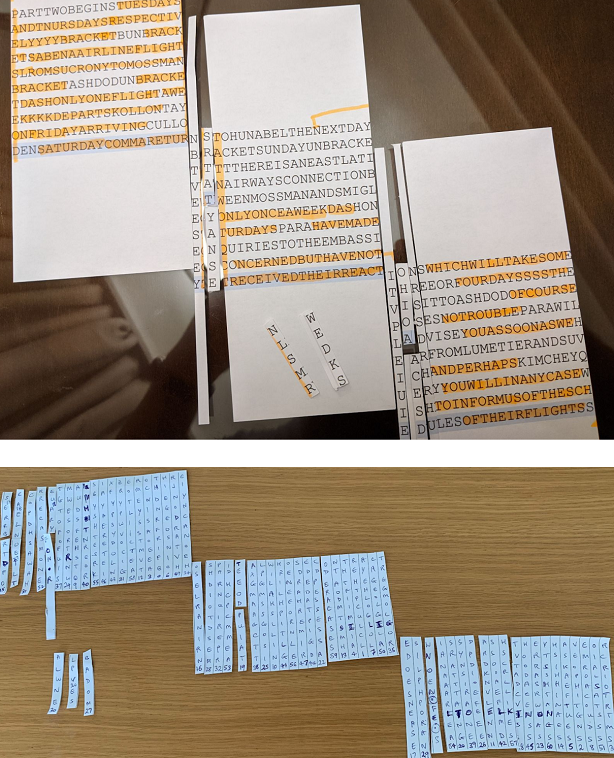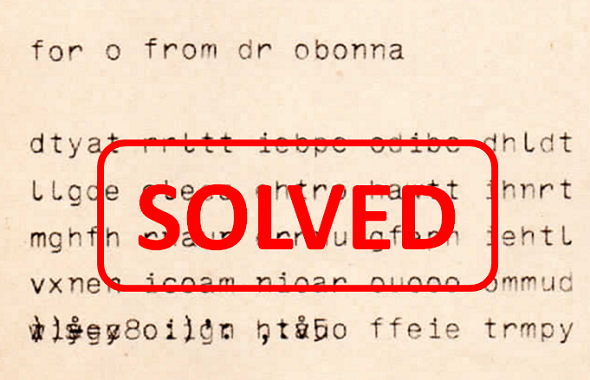Blog readers Richard Bean, Frode Weierud and George Lasry have broken most of the ciphertexts from the Biafran War I recently introduced.
Frode Weierud, a Norwegian Enigma and crypto history expert, earlier this year published a report about a collection of ciphertexts from the Nigerian Civil War (1967-1970).
The Biafran Ciphers
The Nigerian Civil War, also known as the Biafran War, was fought between the government of Nigeria and the secessionist state of Biafra. The conflict resulted from political, economic, ethnic, cultural and religious tensions. Control over the lucrative oil production in the Niger Delta played an important role.
Frode obtained these ciphertexts (Biafran Ciphers) already in 1969. They had been transmitted by radio teletype between Biafra and Lisbon, and apparently somebody in Norway had intercepted them. Frode tried to decipher the messages, but to no avail. He considered publishing them in a Cryptologia article in the late 1970s, but decided not to do so, as they stemmed from a recent war and the content still could have been sensitive.
40 years later, Frode thought that it was now safe to publish the messages. So, he made scans and transcripts of them available on his website.
The scans are provided in some 60 PDF files. The messages were sent between August 2nd and October 21st, 1969. Some consist of five-letter groups, the others of five-digit groups. This suggests that two different ciphers were used. The following scan shows a message of the letter type:

Source: Weierud
A frequency analysis of the five-letter-group messages showed a distribution corresponding to English plaintext, which made Frode believe that they were enciphered by a transposition system. The messages are divided into a number of blocks that often, but not always, consist of an odd number of groups.
For instance, the message BAL025 from 04 August 1969 is divided into four blocks marked 71/4, 142/4, 11/4 and 22/4. The number behind the slash is the date when the message was encrypted. It therefore seems logical to believe that the same or a similar transposition is performed on each of these blocks.
Here’s a digit type message:

Source: Weierud
The system used here is most likely a code but it could also be a substitution cipher. No detailed analysis has been made of this system largely because there are so few of these messages.
Solution of the five-letter-group messages
On November 20th, I blogged about the Biafran Ciphers. Some of my readers posted interesting comments, which helped to better understand these cryptograms. However, nobody came up with a solution.
Last week, I received a mail from my friend and blog reader George Lasry, who is known as an outstanding codebreaker. George wrote: “After an intensive collaborative effort, we (Richard Bean, Frode Weierud, and myself) were able to decipher all the letter ciphers in the collection. The digit ciphers are still unsolved.”

Richard Bean, Frode Weierud, George Lasry (Sources: Bean, Weierud, Schmeh)
It was immediately clear that the solution George had sent me was correct. George provided me a PDF that describes the steps of the deciphering process. Working closely together, Richard, Frode and George all had made critical contributions at various stages of the codebreaking, looking at various angles of the problem.
Here’s how Richard, Frode and George found the solution (according to the document they provided):
- As mentioned above, the five-letter-group messages had already been identified as transposition cryptograms. But it was not clear what type of transposition had been employed.
- The messages were transcribed using Google Docs OCR and manually corrected.
- On November 24, two short messages were decrypted, assuming that a regular columnar transposition cipher with a complete rectangle of 22 columns and five rows had been used. This decryption proved successful, but it turned out that two of the columns had no meaning and could be discarded.
- Trying the same process failed for other messages, despite the use of advanced algorithms that usually solve columnar transposition ciphers with long keys.
- Various attempts were made for anagramming multiple messages from the same day and using the same key, but to no avail.
- No progress was made until December 12, when it was found that when assuming a column height of 10, some word fragments could be seen, such as “visa”, “certificate”, “message”, in one of the messages.
- Assuming similarly long keys, more fragments could be found in five other messages.
- Using pen, paper, and scissors, the team was able to reconstruct the full text for those messages (see picture below).

Source: Lasry
- Two sets of five letters were left unused (NLSMR, WEDKS) – those might be nulls or indicators. Some adjustments had to be made manually to correct the computer solution.
- The same process could not be successfully applied to any of the other messages. So
the team analyzed the various pen-paper-scissors results in order to recnognize
a pattern. It was observed that there was a similarity in the reordering of the columns of
the two or three parts of each cryptogram. An assumption was made about how the
cryptograms may have been created:- a. Write some plaintext in a transposition rectangle of width 20 or 21.
- b. Apply a standard columnar transposition, and obtain an interim ciphertext. Split
the ciphertext into two blocks. - c. The twist: Take the first 30 letters of the ciphertext and move them to the end of
the first block. - d. Insert an indicator at a distance of five from the end of the first block and another one at a distance of 25.
- e. Transmit the modified ciphertext.
- Based on this assumption, the team was able to decipher most of the letter-based cryptograms. The key length was either 20 or 21, and the transposition rectangle was complete.
Example, BAL151(b)
Key: 8,0,15,20,10,9,6,4,1,14,16,2,13,12,17,18,11,5,19,3,7
PARTTWOBEGINSOFTWOUNN AMEDGERMANFILMCOMPANI ESSSSTHEYALSOCLAIMTHE INTERESTOFAMERICANAND FRENCHTTTVVVSTATIONSS SSBOTHGENTLEMENAREKNO WNSUPPORTERSANDFRIEND SOFBIAFRAAAAWHILETHER EISNOLOCALOBJECTIONTO THEIRVISITCOMMABUTINT HEIIGHTOFTHEINSPECTOR GENERALOFPOLICELETTER REFERENCESSSONEZEROTW OSTROKEONESEVENNINEON EOFONESIXAUGUSTONENIN ESIXEIGHTCOMMAYOUCONS IDERTNEIRVISITNOWOPPO RTUNEDANDINTHEINTERES TOFDALFONPLEASECONVEY APPROVALEARLIESTTTTTT
- The same key lengths were tested for the remaining cryptograms, which turned out to be incomplete columnar transpositions.
Example, BAL30
Key: 6,0,10,16,7,11,9,2,12,17,14,13,8,18,3,5,15,1,4,19
SECRETPARFIVENINENIN EFORUGWUMBAFROMCCPAR AREFYOURMESSAGEFAFFI VEZEROFIVEEEECKECKED WITHDIKEANDAMOUNTINV OLVEDISONEFOURZEROZE ROZEROREPEATFOURTEEN THOUSANDDOLLARRNOTRE PEATNOTFOURTEETHUNDR EDDDDTHISISQUIUECONS IDERABLEFORMYPUCKETT TTEILLADVISETHFTMATT ERBETAKENUPWITMTAGBO WHOWILLBEHOMESLONSOT HATHECANPICKUPTHEBCL LLLLL
- Next, the team was able to reconstruct the indicator system. There is a base key, consisting of 15 or 16 letters and valid for a certain period, as well as a message key, used only for the specific message. The message key consists of five random letters, sent as part of the cryptogram. It is appended to the base key to create a keyword from which a transposition key is built. This system explains why anagramming on multiple cryptograms failed, as the keys for different cryptograms are similar but not identical.
- The team is in the process of analyzing the contents of the messages, which include
codewords and topics such as travel arrangements, shipments of material including
weapons, and logistics for foreign aid staff. They plan to publish the full results of the
research in a joint paper.
Congratulatuions to Richard, Frode and George on this impressive codebreaking success! This is a great example of teamwork in the service of historical cryptology research. I am proud that my blog was involved in it.
Follow @KlausSchmeh
Further reading: Who can break the cryptograms of Civil War spy Robert Bunch?
Linkedin: https://www.linkedin.com/groups/13501820
Facebook: https://www.facebook.com/groups/763282653806483/



Kommentare (4)